A Complete Travel Guide to Inner Mongolia
Inner Mongolia is an inland Mongolic autonomous region located in Northern China. It is the third-largest province-level subdivision in China, covering approximately 1.2 million square kilometers, about 12% of China’s total territory, more than four times of the United Kingdom. Curved in a banana shape, Inner Mongolia borders the Republic of Mongolia and Russia to the north, and Heilongjiang, Jilin, Liaoning, Hebei, Shanxi, Shaanxi, Ningxia, and Gansu provinces from northeast to southwest.
Due to the long stretch from east to west, Inner Mongolia is geographically partitioned into eastern, central, and western divisions. The eastern division is usually contained in northeast China with primary cities like Hulunbuir, Hailar, Tongliao, Chifeng. The central division is included in north China with major cities like Ulanqab, Xilin Gol, Hohhot. The western division is included in northwest China with main cities like Baotou, Bayan Nur, Ordos, Wuhai, Alxa.
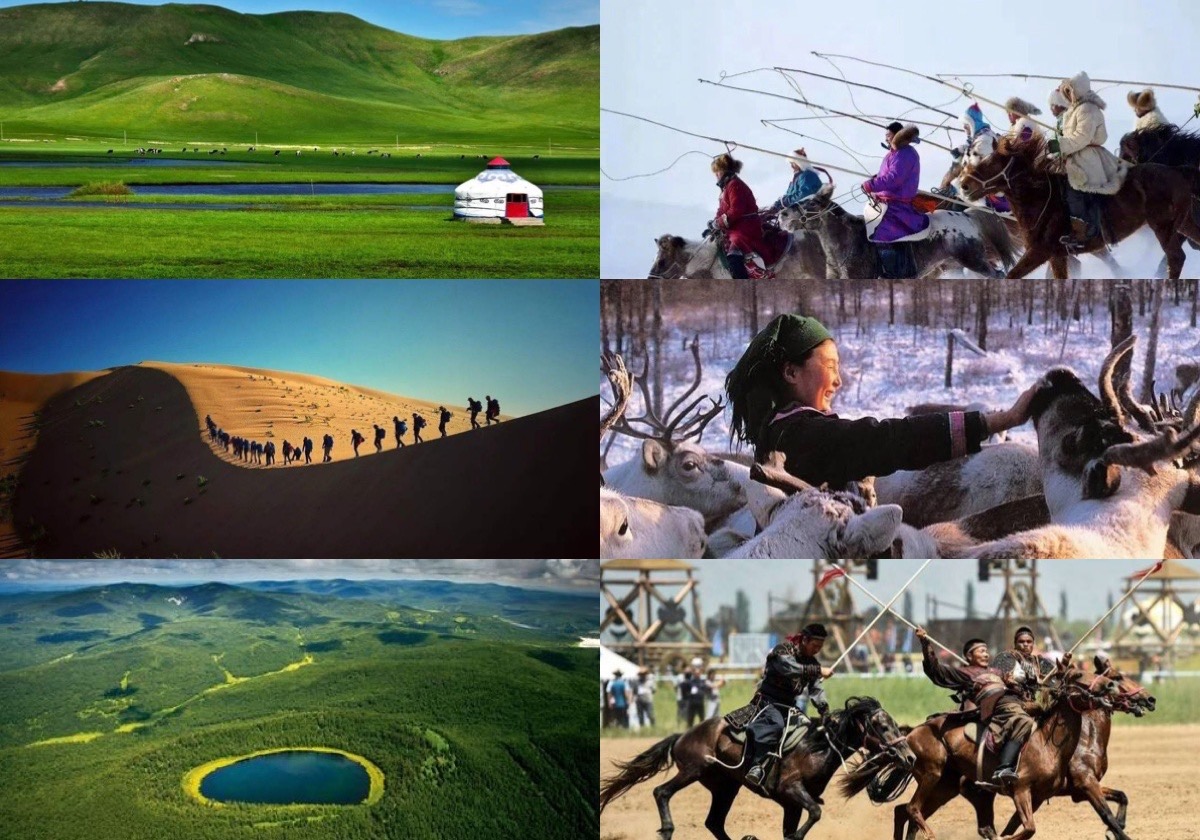
With a particular geographical position, Inner Mongolia boasts every kind of landscape imaginable. In the eastern and central division where vast grasslands and primitive forests are dotting, Mongol nomads still use the gently undulating plains as rangeland for their horse; head west, travelers will hit emerald lakes hidden amid the shimmering sand dunes of endless deserts. It's a perfect destination for your China tour if planning to follow the traces of the “real” Mongolia remains, in the matter of both landscape and people.
- Highlights in Eastern Inner Mongolia: Hulunbuir, Arxan, Hailar
- Highlights in Central Inner Mongolia: Hohhot, Ulanqab, Xilingol
- Highlights in Western Inner Mongolia: Ejina, Alxa, Ordos
- Best time to visit Inner Mongolia, Inner Mongolia climate
- How to get to Inner Mongolia and travel around
- Recommended tour and itineraries for Inner Mongolia
- Accommodation and food in Inner Mongolia
- Useful travel tips

Highlights in Eastern Inner Mongolia: Hulunbuir, Arxan, Hailar
Hulunbuir Grassland
Named after Hulun Lake and Buir Lake, Hulunbuir Grassland is a natural pasture located in the northeast of Inner Mongolia, facing the Daxing’anling Range (the Greater Khingan Range, China’s largest forest zone) to the east. Being reputed as the “Grass Kingdom'', it is the best-preserved grassland in China with most of its natural ecological environment such as forests, meadows, lakes maintaining their original appearance. Covering an area of about 100,000 square kilometers with 80% coverage of natural grassland, it is one of the largest grasslands in the world. Being the cradle of the nomads in northern China, Hulunbuir Grassland, blessed by nature, has provided rich and fertile soils for breeding the ancient civilizations of many northern nomads, such as Mongolia, Turkic, Khitan, Jurchen.
Hulun Lake
Hulun Lake, also called Dalai Nuur meaning Ocean-like Lake in Mongolian, surprisingly pops out of Hulunbuir Grassland like a colossal inland sea, about 47km away from Manzhouli. Covering about 2,333 square kilometers, it is the largest lake in Inner Mongolia and one of the largest freshwater lakes in China. To feel the lake’s true beauty, travelers can choose to stroll along the north shore of the lake, go horseback riding, watch water birds, take a cruise and go fishing, or simply camp close to the west shore and enjoy the extraordinary sunrise. To appreciate the full colors of the surroundings of Hulun Lake, best to go in summer and early autumn.
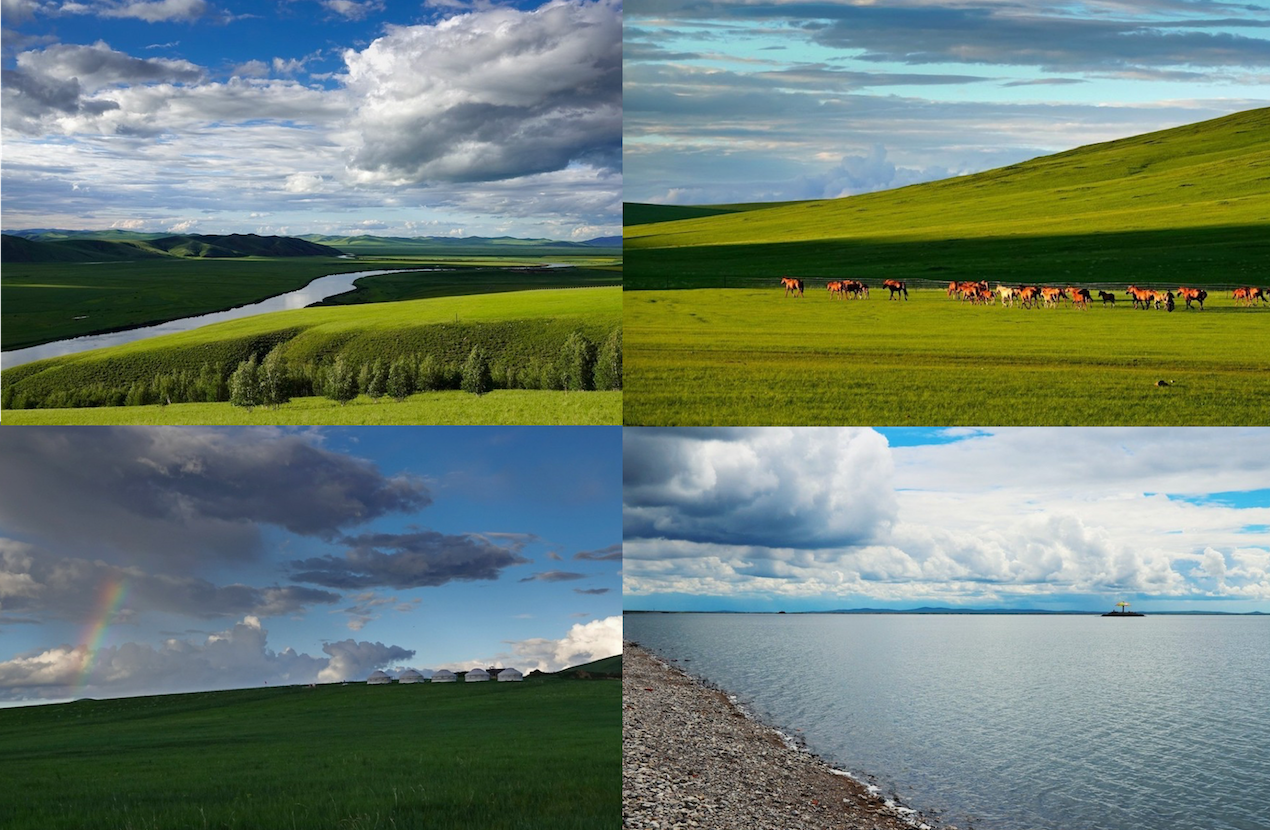
Manzhouli
Located in Hulunbuir of Inner Mongolia, bordering Mongol and Russia on the west and north respectively, Manzhouli is a transliteration of a Mongolian word which means “luxuriant spring water”, and named after the railway station built there in 1901. This garish pastel-painted thriving city brings together the border gate, the Matryoshka Doll Square with the largest Matryoshka dolls in the world. The Ice & Snow Festival takes place there every winter from February to early March, where travelers can appreciate different themed large ice and snow sculptures and join winter activities, though a smaller version of the one happens in Harbin.
Ergun Wetland (Genhe Wetland)
Ergun Wetland, formerly known as Genhe Wetland, is located in Ergun city in Hulunbuir of Inner Mongolia. Covering an area of 126,000 hectares, it is one of the largest wetlands in China. Coming to be home to a wide range of plant and animal species, Ergun Wetland has good displays of the wealth of life in its diverse ecosystem. Get atop the hill, travelers will be immediately convinced of what claims to be the “No. 1 Wetland in Asia” by the panoramic view, that is the verdant green giving way to sparkling golden willows, bushes, poplars, and birches which spreads along the slopes as well as both banks of the zigzagging Genhe River, which flows into the nearby Ergun River.
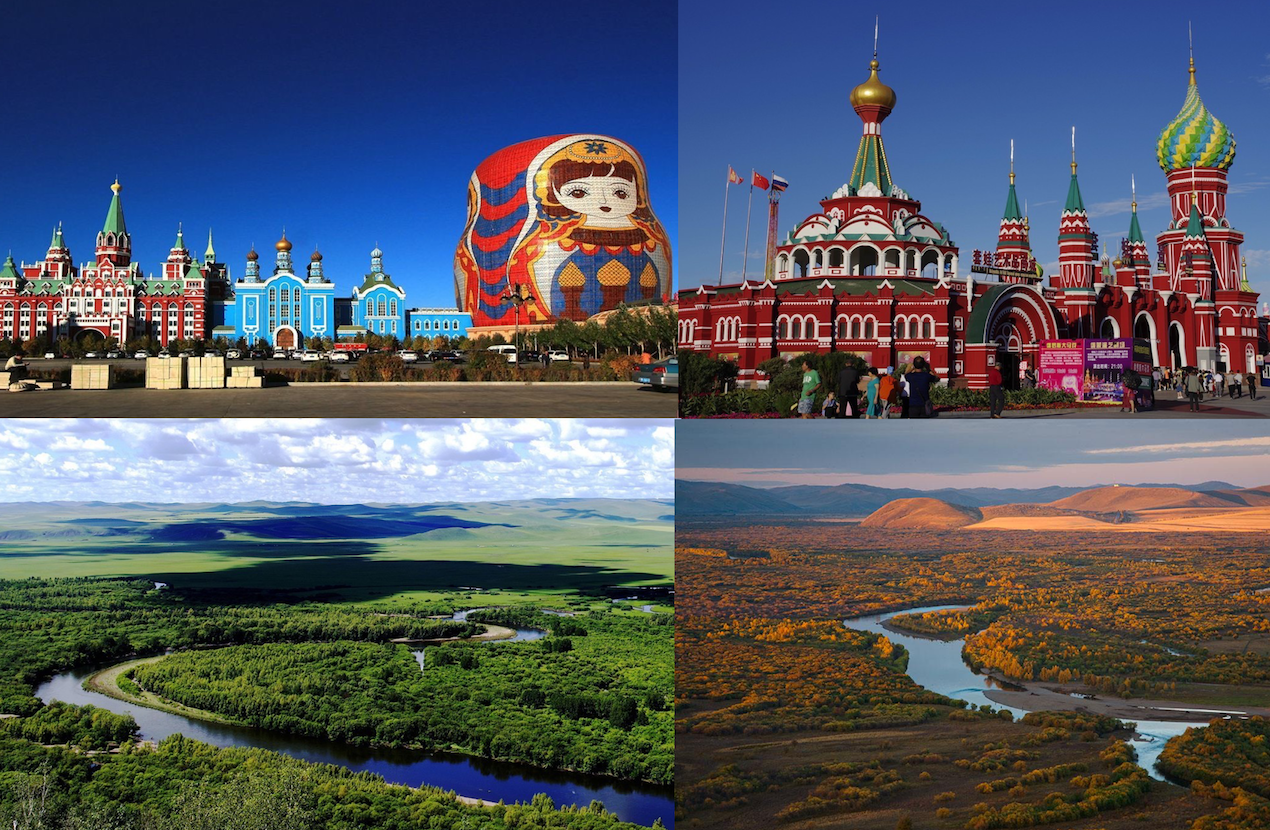
Arxan National Forest Park
Arxan National Forest Park, embedded in the southwest foothill of the Greater Khingan Range, is located in Arxan, Hinggan, Inner Mongolia. It houses the highest peak of the Greater Khingan Range - Terme Mountain [1,378m] and the largest lake of the Greater Khingan Range - Darbin Lake, as well as the Shitanglin Forest and Heavenly Lake which are formed by solidified lava. From the Grand Canyon with thick golden pine forests and various shaped volcanic rocks to the crater lake on Camel Hump Mountain with a well-maintained ecological environment, the park is full of so many great places to see. Move southwest, follow the primitive pine forest and bizarre solidified lavas, an L-shaped lake will surprise you with surrounded flaming azalea flowers in Spring, as well as a natural ski field in winter.
Reindeer Tribe in Aoluguya
Aoluguya is a township in Genhe City, located in the core of the primitive forests in the northern part of the Greater Khingan Range. In “Aoluguya” (means a place with flourishing aspens), there lives a mysterious ethnic minority group - the Ewenki people, who are called “reindeer tribe” as they are the only ethnic-minority people in China making a living by raising reindeer. Reindeer were their major methods of transportation in the past and their closest friends. Nowadays, while many Ewenki herders have taken modern lifestyles, there are more than 30 veteran herders still keep the traditional way of raising reindeer and use their ways to promote reindeer conservation to the rest of the world.
Arshihaty Stone Forest
The Arshihaty Stone Forest is situated at the Hexigten Banner of Chifeng. Perched on the transitional area from the remnants of the Greater Khingan Range to the grassland in the west, the Arshihaty Stone Forest is a famous forest of granite columns carved by frost splitting, freezing, thawing, and wind erosion, which is rarely seen elsewhere in the world. Geologically, the mysterious and unique rocks and stones are relics of the Quaternary Glacier, so it is also called the “Glacial Stone Forest”. As an integrated part of Hexigten World Geopark, the scenic area of Arshihaty Stone Forest consists of five areas: the Moon Castle, Sworn Brothers, Eagle with Folded Wings, Fortress Besieged, and Live Folk Entertainment.
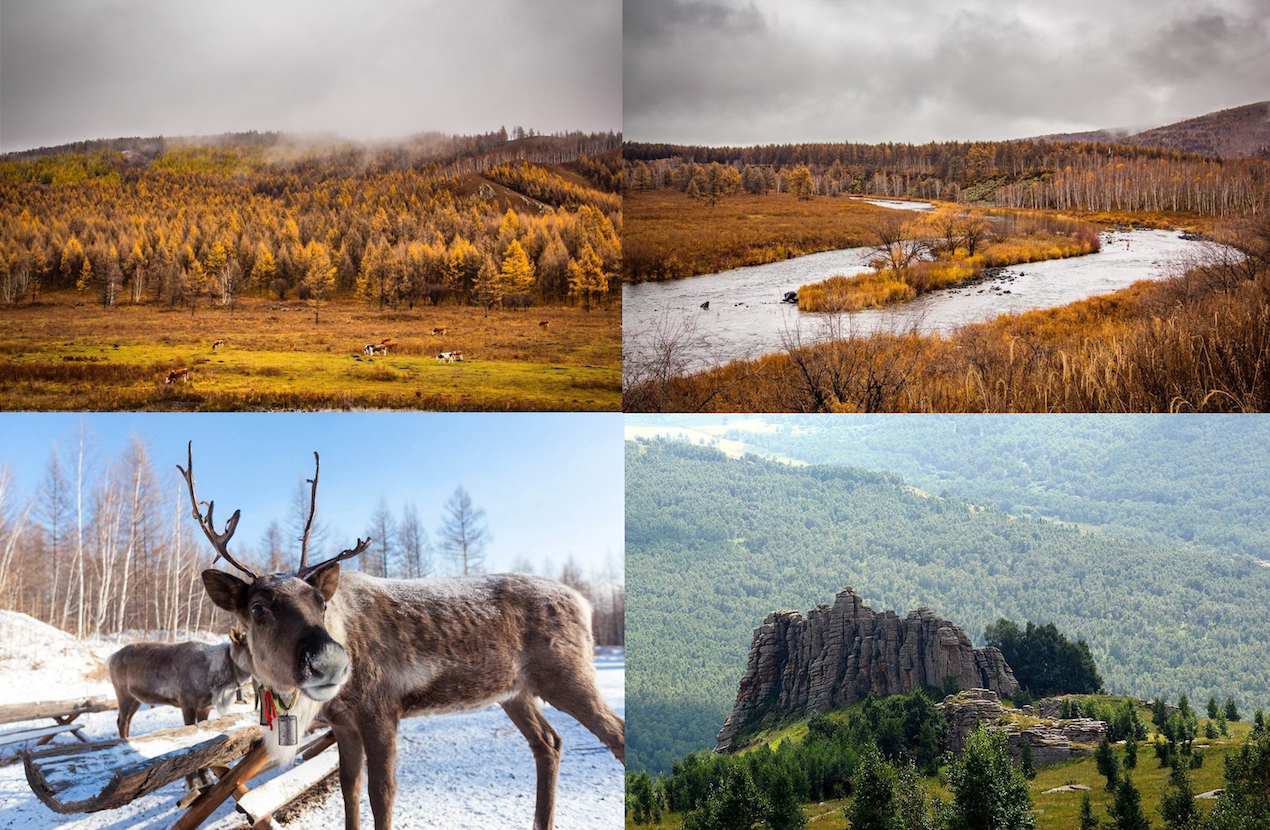

Highlights in Central Inner Mongolia: Hohhot, Ulanqab, Xilingol
Gegentala Grassland
Located in the hinterland of the Ulanqab Grassland, Gegentala Grassland is about 128KM from the provincial capital Hohhot. In Mongolia, “Gegentala” means “the summer resort” or “the place for grazing in summer”. It has been a great natural pasture since ancient times, with vast fertile grassland, herds of horses, and flocks of sheep. As the first government-owned grassland, Gegentala Grassland has been appealing to many travelers from domestic and abroad since 1979. It’s getting more vivid now, with striking prairie scenery and colorful featured Mongolian activities. The flourishing grass, undulating hills, galloping horses with yelling herdsmen, soaring hawks, and traditional yurts, forming a dynamic picture presented by nature.
Huitengxile Grassland
Huitengxile Grassland is located in the Chahar Right Middle Banner, in the city of Ulanqab of Inner Mongolia, about 135km away from Hohhot. In Mongolia, Huitengxile” means “Cold Plateau”. It’s getting particularly cool in summer, with an average maximum temperature of 18°C, so it is known as a "summer resort". With an average altitude of 2,100m, it is a typical alpine meadow with complex geology, overlapping peaks, and rich grass species. There are 99 natural lakes like shattered mirrors scattered on its grassland, making it extremely elegant and energetical. Besides the spacious grassland and natural lakes, there is the largest wind power plant in Asia, as well as many historical relics, such as Great Wall ruins, Woyang City ruins.
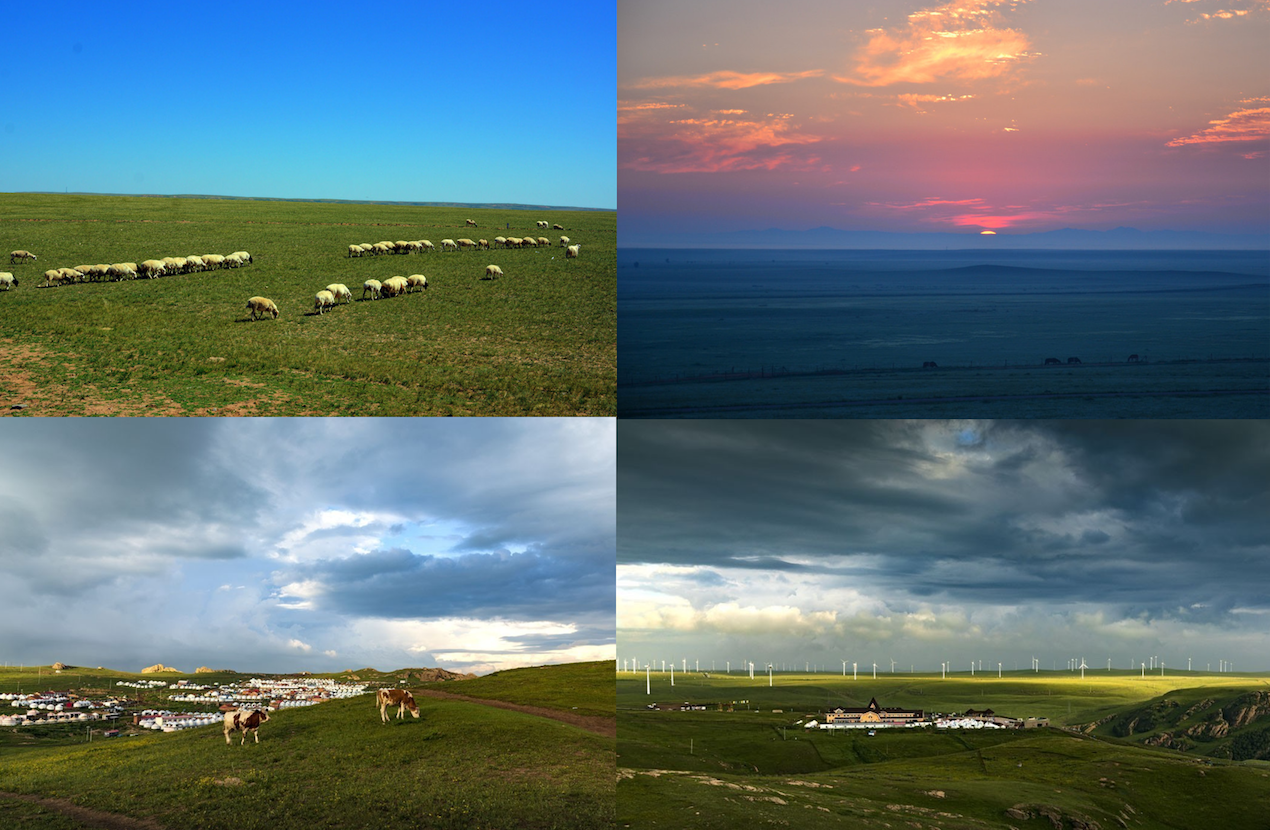
Xilamuren Grassland
Xilamuren Grassland is located in the Xilamuren Town of Baotou City, but it is more close to Hohhot (about 88km) than Baotou (about 180km). It is the nearest grassland to Hohhot with about 1.5 hours drive. “Xilamuren” is previously called “Zhao River” (“Zhao” means “Temple” in Mongolia), because there is an old lamasery called Puhui Temple situated on the bank of Xilamuren river, which is served as the summer palace of Xilitu Buddha. A visit to Xilamuren Grassland allows travelers to have great unforgettable experiences, such as a traditional welcome ceremony, taste of kumiss and local Mongolian food, horse riding, and staying in a traditional Mongolian yurt…whilst enjoying the mesmerizing scenery of endless grassland.
Dazhao Temple
Dazhao Temple, or Wuliang Temple, the first building of Hohhot, is one of the oldest and largest temples in Inner Mongolia dedicated to the Tibetan Buddhism of Gelugpa order. Unlike its older brother in Lhasa enjoyed kinds of respect, Dazhao Temple had been ignored for the first decades since it was originally built in 1579, and gained its fame among people from all over Mongolia, until 1586 when the 3rd Dalai Lama came to the temple and consecrated a gigantic silver statue of Sakyamuni. Besides the 10ft silver buddha statue, the temple houses another two treasures: the remaining murals and the lifelike dragons carved on the aureate pillars that sit on both sides of the statue.
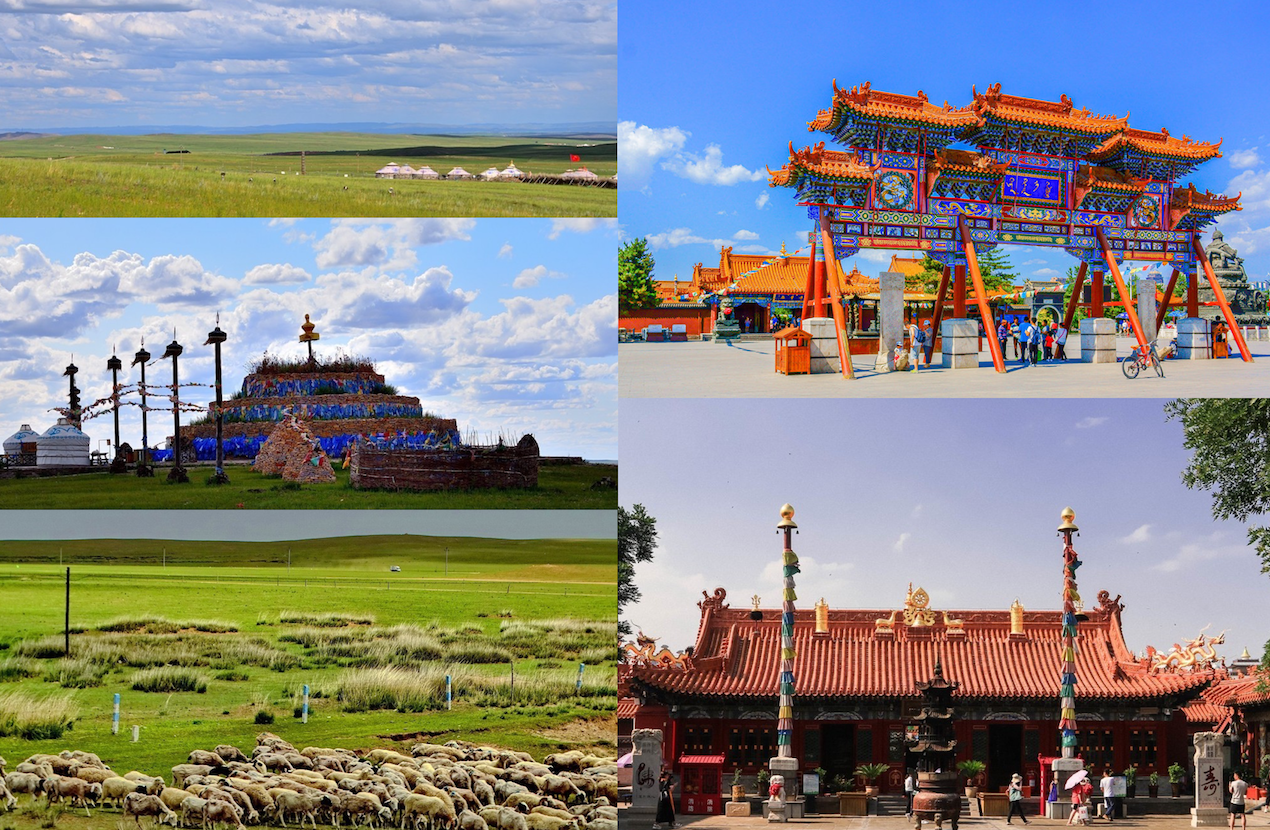
Zhaojun Tomb
Zhaojun Tomb is perched on the Dahi river, about 9 km from the city of Hohhot. It is an honorary mound in commemoration of Wang Zhaojun, a commoner woman from the Han dynasty who married a Xiongnu Chanyu (nomadic chieftain from the grasslands) and brought a harmonious relationship enjoyed by both Han and Xiongnu people. Even though her remains are not actually buried beneath this 33-meter-high tomb, it’s still noted for its remarkable scenery and striking statues. There are stone staircases leading to a view deck for the panoramic view of the scenery around the tomb, as well as the outline of the drizzly Yin Mountains uplifting in the distance.
Five Pagoda Temple
Five Pagoda Temple is in the surrounding area of Qingcheng Park, located in the old part of the city of Hohhot. Built according to the complex of the Gaya Temple in India, it is one of the special “diamond throne” pagodas of Indian Buddhist architecture. Unlike other pagodas, the Five Pagoda Temple features short eaves and tops of pagodas which are glazed in green and yellow color. The complex is a megastructure consisting of the base of the pagoda, the Buddha’s warrior seat, and the superstructures (the five stupas), resembling a mausoleum with five exquisite quadrangle minaret-like pagodas on the top of it.
Wanbu Huayanjing Pagoda
Known as White Pagoda, it's located in Baita village of Hohhot. Built-in the Liao Dynasty, the pagoda is a superior example of ancient Chinese architecture that has endured for almost 1,000 years. Standing at a height of 55 meters, it is a serve-floor brick and wood structure in octagonal shape. With a large number of statuettes of Buddhas, Bodhisattvas, and Warriors depicted in different stances along the external side of the pagoda, as well as many Buddhist scriptures and inscriptions in multiple languages. It was listed as a national cultural relic site in 1982 at the highest level of protection in China.
Inner Mongolia Museum
Inner Mongolia Museum, a massive provincial museum, sits on Xinhua Street in the city of Hohhot. The museum, with an exceptional inclined roof resembling the boundless grasslands of Inner Mongolia, particularly gives an insight into the history and traditions of the Mongolian people, from the exhibition dedicated to the life of Genghis Khan to the exhibition of ethnic relics reflecting the daily life of nomadic Mongols, including production, culture, folklore, art, and religion, as well as the display of complex Mongol bone carvings describing historical events. In addition, the museum is well-known for its large-scale collection of well-preserved fossil skeletons of dinosaurs, Mammuthus, coelodonta antiquitatis, and fossil faunas in the Mesozoic era and Cenozoic era, attracting numerous fossils addicts from all over the world.
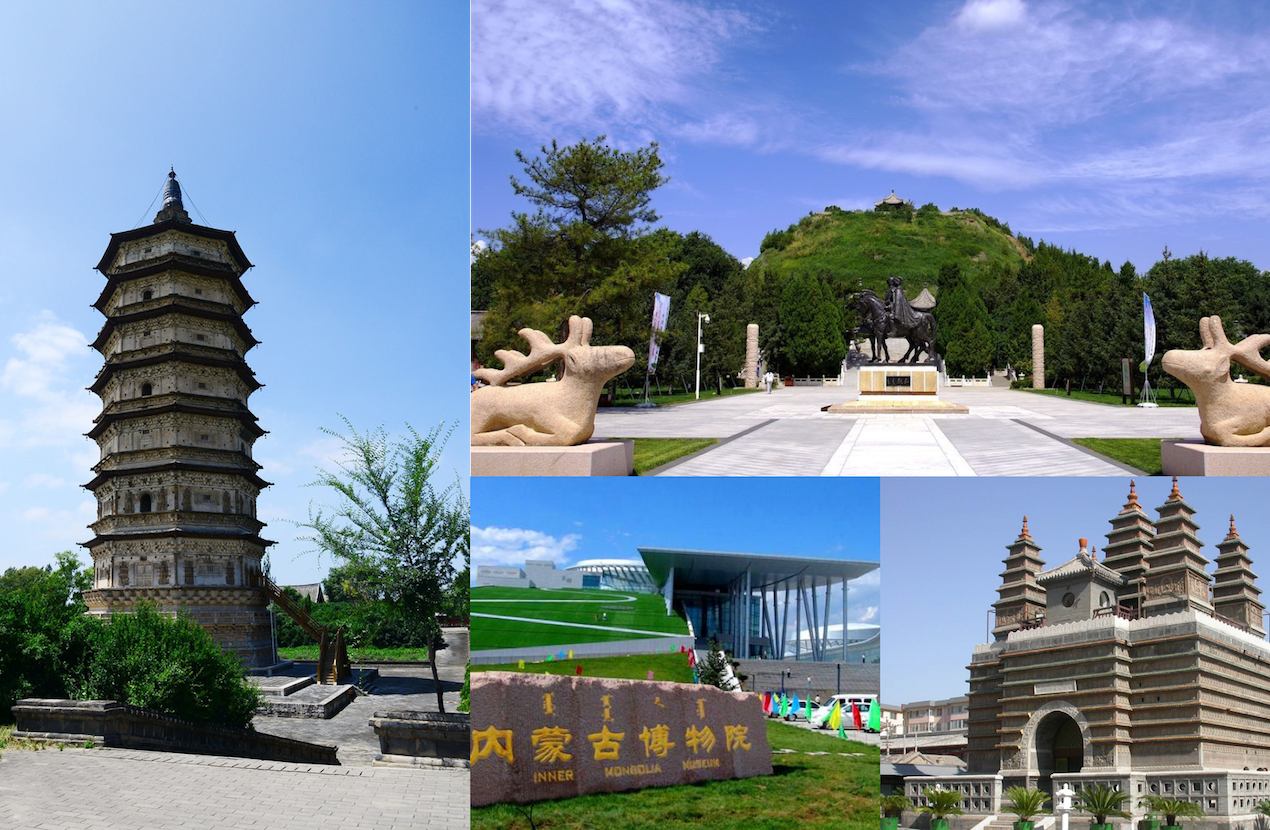
Xilingol Grassland
Xilingol Grassland, one of China’s four largest grasslands, is situated in Xilinhot City of Xilingol League of Inner Mongolia. Constituting the main portion of natural pastures in Inner Mongolia, it is the most typical temperate steppe composed of grassland, marshlands, wetland, and sand dunes, with various types of vegetation and plentiful plant species. Being reputed as a paradise of grassland and the most beautiful grassland in north China, it allows travelers to appreciate an impressive view of the nine-bend river, the desert-steppe, and a transition belt from the meadow grass to the birch forest, with the opportunity to experience the nomadic lifestyle and learn their culture.
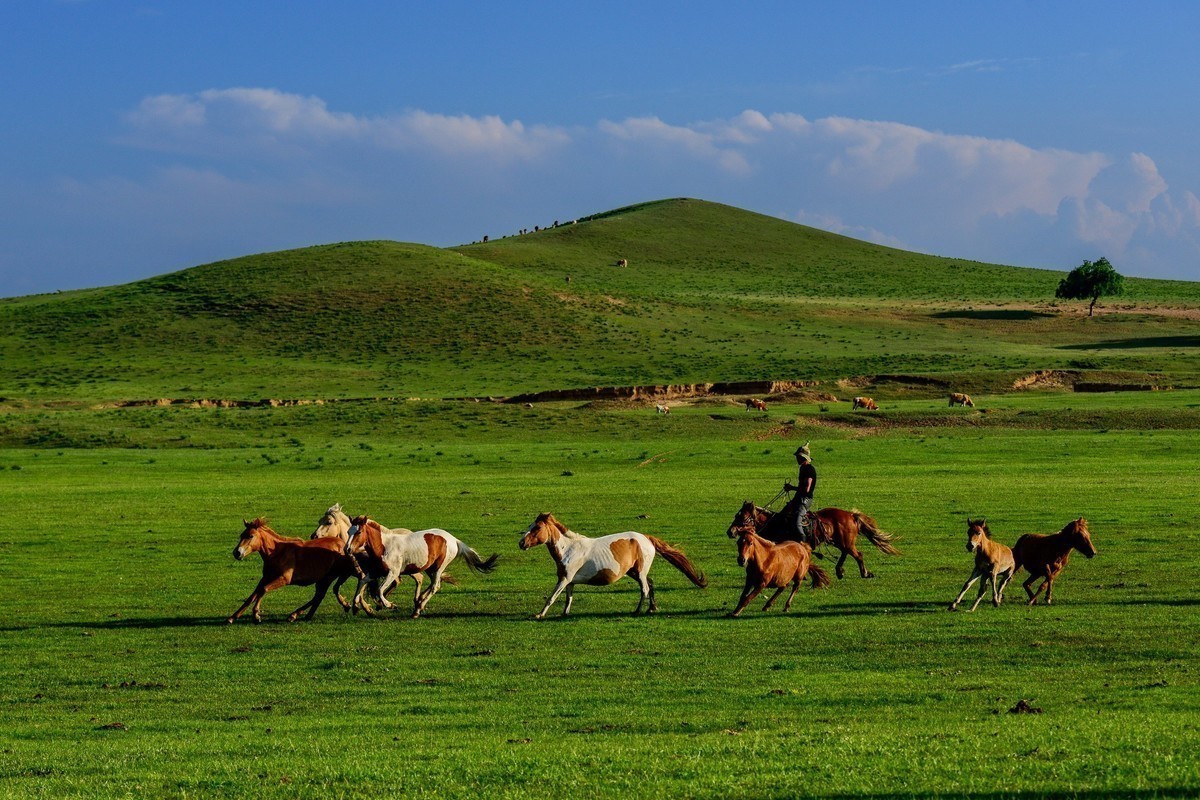

Highlights in Western Inner Mongolia: Ejina, Alxa, Ordos
Ejina Populus Euphratica Forest
Located in Dalaihob Township, Ejina Banner of Alxa League, covering a total area of 3,800 square kilometers, Ejina Populus Euphratica Forest is one of the three remaining natural forests of Populus euphratica (or Euphrates Poplar or Desert Poplar) - an old kind of poplar tree in the willow group. Another two are in the Sahara Desert and Taklamakan Desert. The locals also call Populus euphratica the “hero tree”, due to its magical ability to withstand drought, wind-driven sand, and its tenacious vitality in the desert. Each autumn, around the period from September 25 to October 15, the forest becomes a photograph paradise with a sea of golden leaves, attracting countless travelers and photographers to enjoy the magnificent scenery.
Khara Khoto Ruins (Black City Ruins)
Khara Khoto Ruins, the most complete and grand ancient city ruins existing on the Silk Road, is located about 22km southeast of the Dalaihob Township in Ejina Banner. Khara Khoto, aka Black City, was established by Tangut Mongols in 1032 as the metropolis of their Western Xia Dynasty (1038 -1227) and turned into a prosperous trade hub. Many architectures have been grounded into nubs by centuries of sandstorms. At the moment, all that is left of this ancient city are the rectangular shaped city walls, five high pagodas shaped like upturned bowls, a variety of collapsing mud houses, and the remains of what is likely to be a mosque on the edges of the outer walls, which lure the imaginations of travelers from afar.
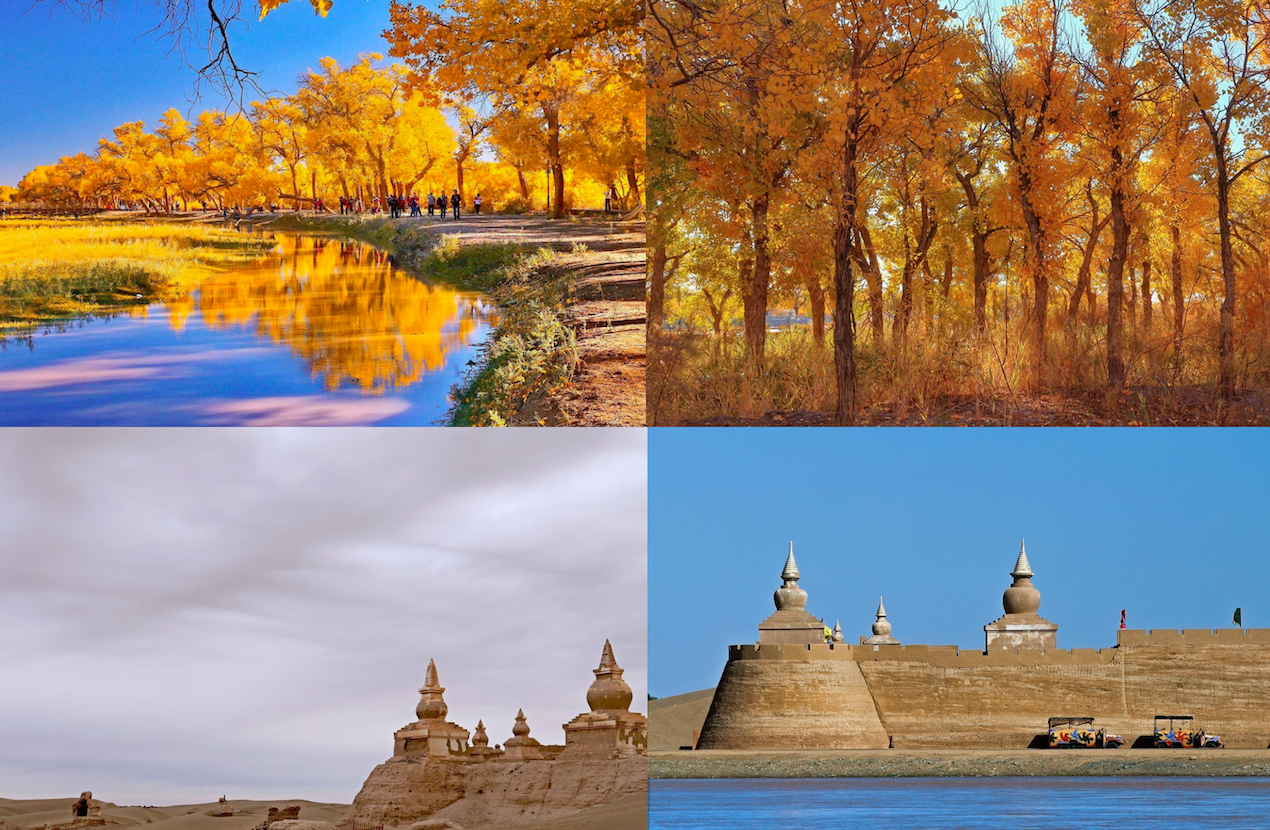
Wudangzhao Monastery
Wudangzhao Monastery, the largest and best-preserved Tibetan Buddhist monastery in Inner Mongolia, is approximately 70km northeast of Baotou. “Wudangzhao” is a Chinese transliteration of Mongolian words for “willow monastery”, thus the monastery is named after the prosperous willows in the valley where the monastery is built. “Badekar Monastery” is its Tibetan name, which means white lotus in the Tibetan language. Constructed according to the layout of Tashilhunpo Monastery in Shigatse, it is a complex of white Tibetan architectures settled horizontally against the background of a green mountain with verdant trees, with halls along the central path ascending up into the mountain.
Mausoleum of Genghis Khan
The world-famous Mausoleum of Genghis Khan is located in the Xinjie Town in the Ejin Horo Banner in the Ordos Prefecture of Inner Mongolia, about 115 km from Baotou. This is the grandest temple paying tribute to Genghis Khan, where he is worshipped as a godlike figure, dynastic founder, and deity of the ancient Turkic religion known as Tengrism. In fact, the mausoleum is a cenotaph where the coffin contains only headdresses and accessories, but no remains of the great Mongol warrior himself. The actual location of his remains has never been discovered because he was buried without any marks according to his will.
Resonant Sand Bay (Xiangshawan)
Known in Chinese as Xiangshawan, the Resonant Sang Bay is located in the eastern end of Gobi’s Kubuqi Desert of Inner Mongolia, about 1 hour’s drive from Baotou. It gets its name from a roaring sound created by sliding down its sand dunes from the top during dry weather, and the sound is similar to that of an airplane. It was the most unreclaimable site, but it was developed as the first comprehensive desert resort, in the process of China's general campaign to fight against desertification. This desert-themed resort contains four "islands" of sand-based entertainment activities surrounding the main site - Xiangshawan Port, as well as the Sand Dune Resort which is used as the reception area.
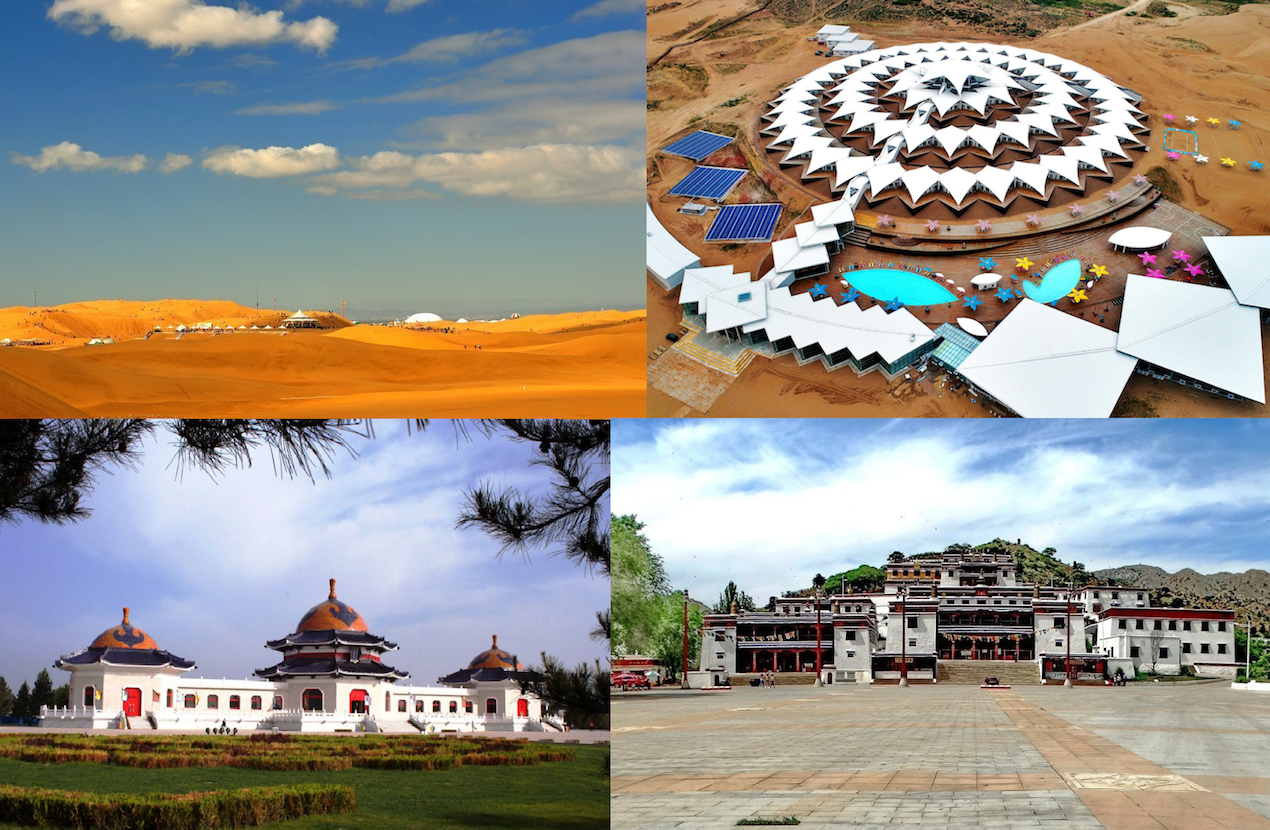
Badain Jaran Desert
Badain Jaran Desert, across Ejina Banner and Alxa Right Banner, is perched on the southwestern edge of Inner Mongolia. Covering approximately 49,000 square kilometers, it is China’s third-largest desert. Serving as the home for myriad natural oddities, such as the tallest stationary dunes in the world, the singing sand dunes, and many scattered colorful lakes, it comes at the first-ranking of the “Five Most Beautiful Deserts in China” picked by “Chinese National Geography”. The highlights include the worlds’ tallest stationary sand dune Bilutu Peak (500 meters/1,600 feet), Badain Jaran Temple, Badain Jaran lake, etc.
Tengger Desert
Tengger Desert is mainly covering the southwest of Alxa Left Banner of Inner Mongolia and straddles the border with Gansu and Ningxia. As the fourth largest desert in China, it covers an arid nature area of 36,700 square kilometers. Tengger Desert is dominated by 71% sand dunes. In addition to the magical landscape of shifting sand dunes with occasional herds of two-humped camels, it’s also an ideal place for hiking and camping with charming inner lakes, flatlands, grassland, and hills accompanied. Among all inner lakes, the Swan Lake is the most famous and recommended with many sand jujube trees and vigorous Malan flowers along its shore.
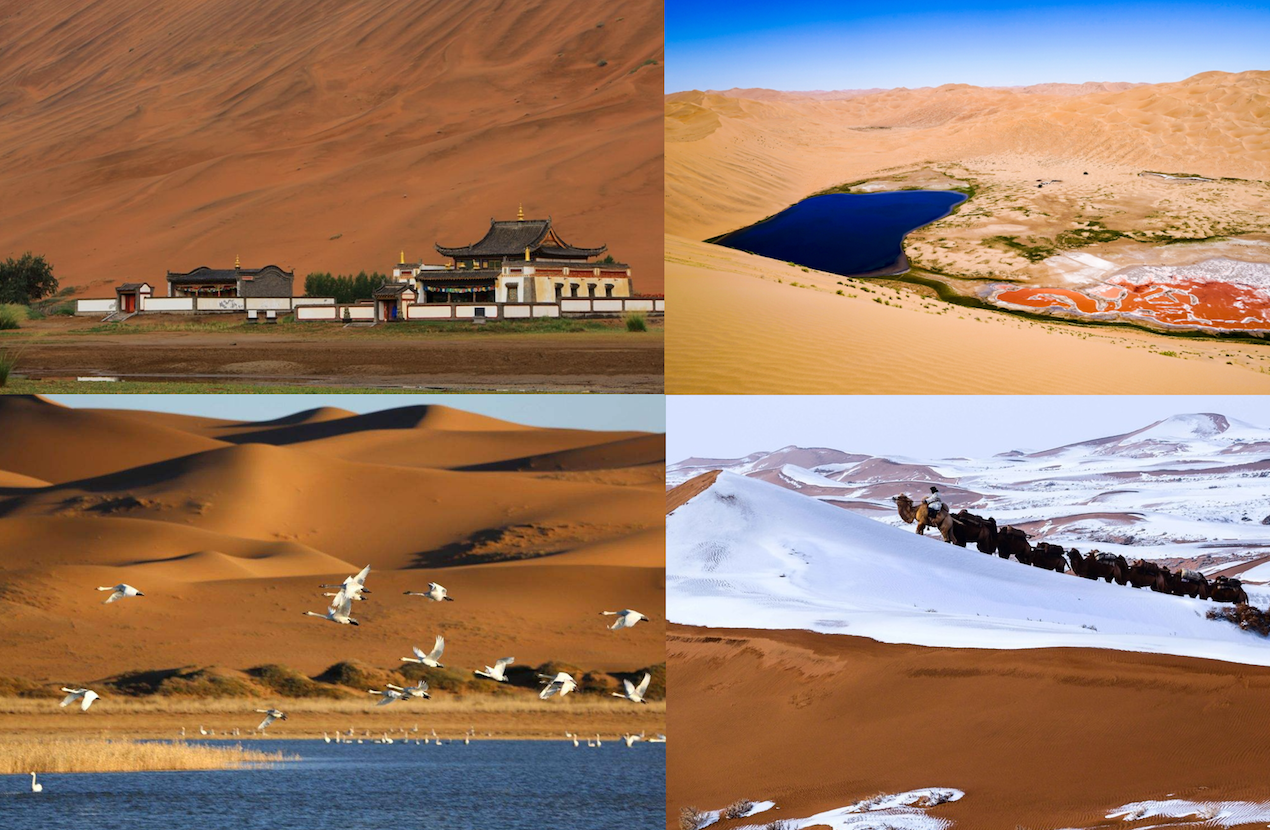

Best time to visit Inner Mongolia, Inner Mongolia climate
Being far off the ocean with vast land and a high altitude above sea level, Inner Mongolia boasts a temperate monsoon climate with few and erratic rainfalls, as well as a sharp change of temperatures. It is widely accepted that the summer between May and September is an ideal time to visit Inner Mongolia. However, considering its wide range, the best time is varied for different parts. For the east area with grasslands, the best time is from July to August when the grass turns green with blue sky. For the west area with deserts, it is suitable for traveling from July to mid-October. For the forest region in the vicinity of the Greater Khingan Range, it is recommended to travel during the middle to late May with blooming wildflowers, or during the middle of September with colorful foliage.
For travelers who wish to witness the region’s Naadam Festival, travel to Inner Mongolia in July. Naadam, also known as “Nair,” means entertainment in the Mongolian language, which is a showcase of Mongols’ athletic prowess and skills. The Naadam Festival, the most magnificent event of the year, happens in grasslands across the region from the 4th of June by the Chinese lunar calendar and lasts for 5 days. During this grandest time, Mongol ethnic people will compete in “three games of men”, and those games are Mongolian wrestling, archery, and horse racing. The festival is far beyond a number of sports competitions but also a celebration of the nomads for spiritual pursuit, which gives travelers a chance to join the local Mongolians with festival activities, including singing, dancing, and the taste of traditional cuisine.
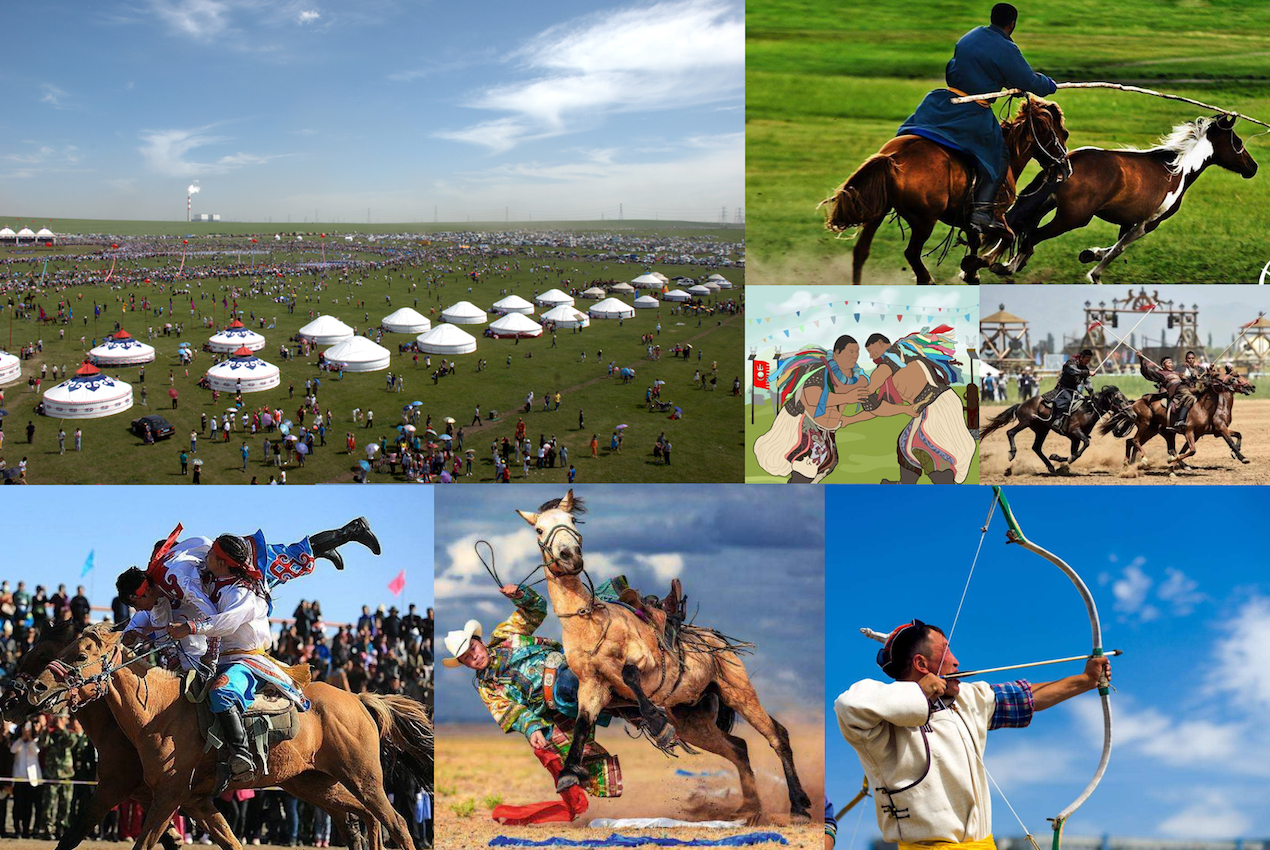
Four Seasons of Inner Mongolia
Spring (April-June): The weather is mild, without too much rain. However, it can be windy with frequent dust storms in the desert areas, and the grass hasn’t turned to be green yet in the grassland areas. Thus we would recommend exploring the cities like Hohhot or Baotou for some historical and cultural sites.
Summer (July-August): Even though summer is quite short, it is the best time to appreciate the verdant and soft grassland with comfortable and cool weather. The temperature is averagely ranging from 17˚C (63˚F) to 26˚C (79˚F). We would recommend a trip either to Hulunbuir Grassland, or one of the grasslands close in the middle division.
Autumn (September-early November): The temperature drops abruptly and the frost always comes early in autumn. But this period is the best time for an adventure to deserts in the western part of Inner Mongolia. Besides, from early to middle October, it is the best time to appreciate the Populus Euphratica Forest in Ejina, which looks like a golden sea.
Winter (mid-November-March): Winter lasts for a very long time, sometimes even more than half a year, which is freezing cold with temperature ranging from -10 °C (-50 °F) to -23 °C (-73 °F). For travelers taking a winter trip to Inner Mongolia, we would recommend visiting the Manzhouli Ice and Snow Festival for the giant ice carving in different shapes.
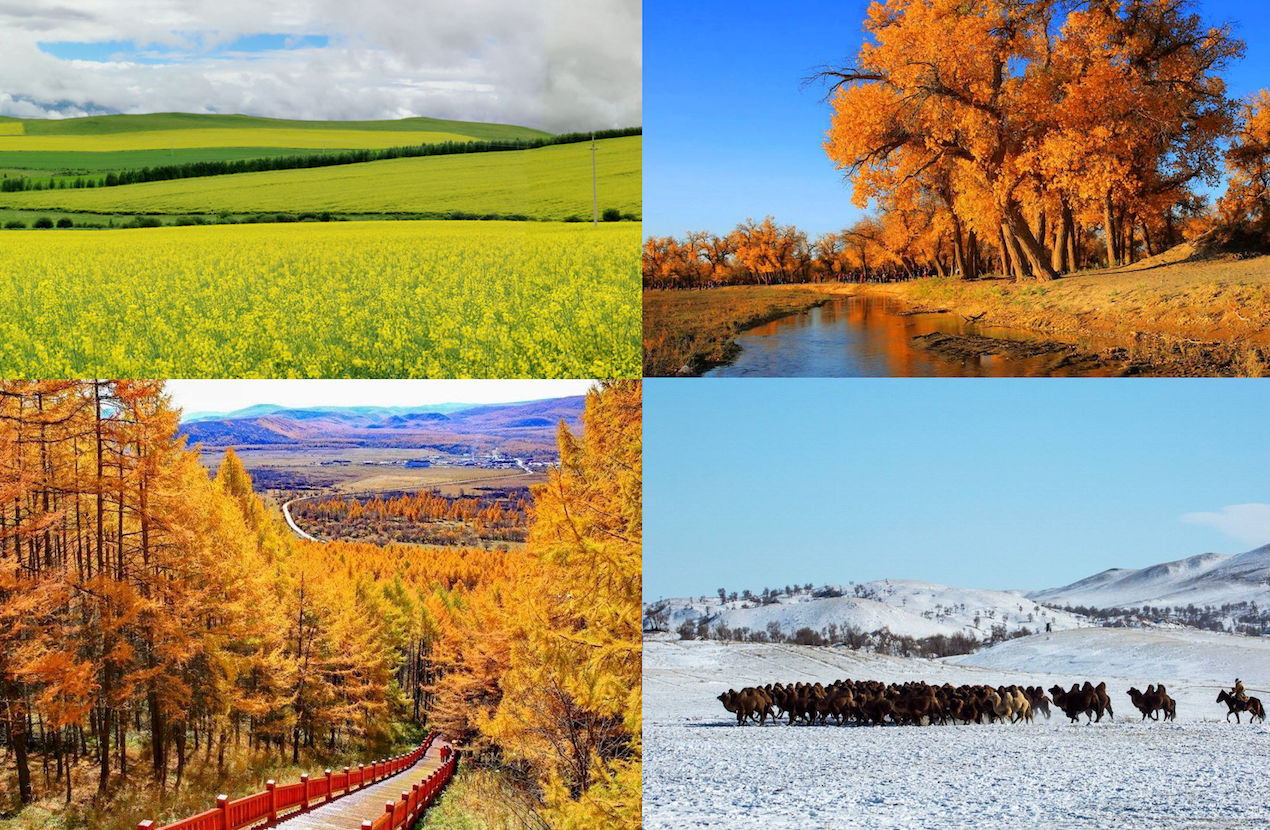

How to get to Inner Mongolia and travel around
With airways and railways as the main transportation, it’s easy and convenient to connect Inner Mongolia with north China, northwest China, and northeast China.
Flight to Inner Mongolia
There are more than 10 public airports in Inner Mongolia, and the most frequently used by travelers are Hohhot Baita International Airport, Baotou Erliban Airport, Hailar Dongshan Airport, Manzhouli Xijiao Airport. Except for the international flights connecting Hohhot and Ulaanbaatar in Mongolia, most airports in Inner Mongolia only provide domestic flights, thus foreigner travelers will need to reach one of the main cities of China, before getting to Inner Mongolia. Most travelers will choose Beijing as the gateway to Inner Mongolia, as there are frequent non-stop flights from Beijing to Hohhot, Baotou, etc.
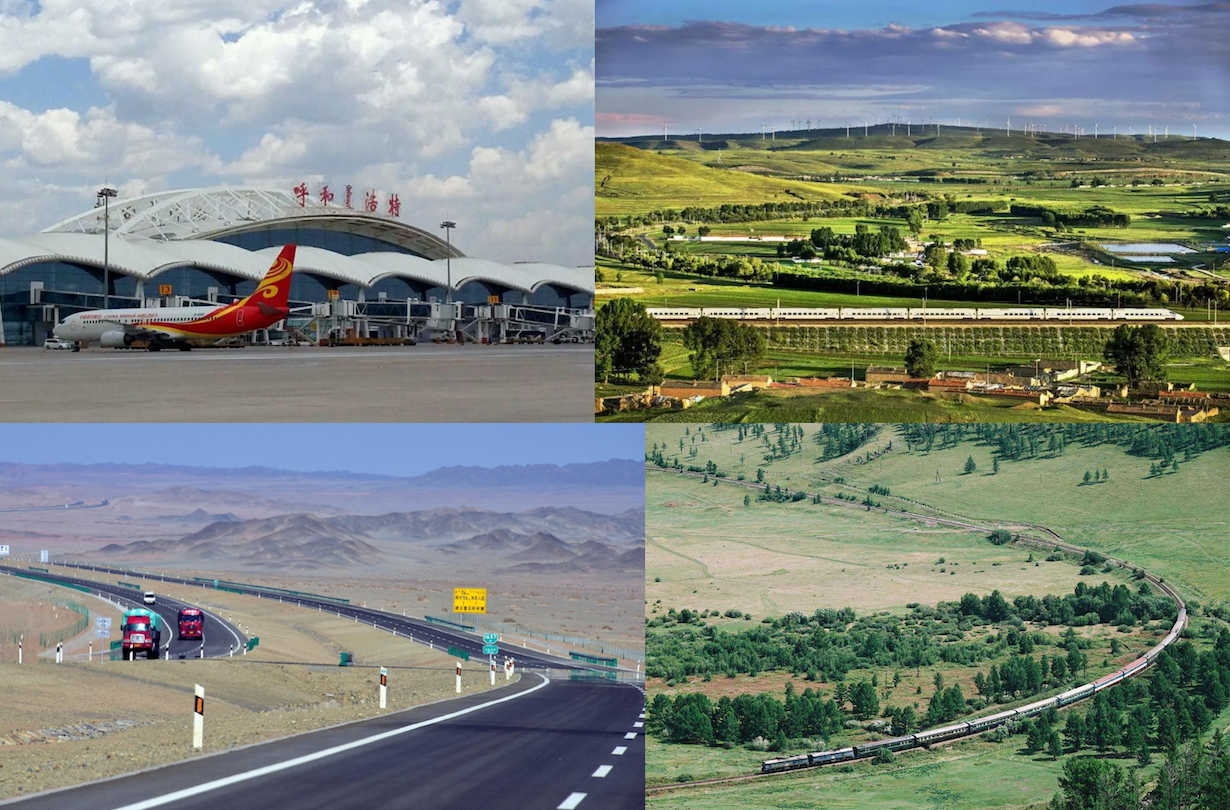
Train to Inner Mongolia
The Chinese railway network links most cities of Inner Mongolia and gives access to the cities of neighboring regions. With great development achieved on transportation, traveling by high-speed train is an easy option within a few hours to reach Hohhot and Baotou from Beijing or Taiyuan, Datong in Shanxi province, to reach Chifeng and Tongliao from the cities in northeast China regions, such as Shenyang, Dalian.
Travel within Inner Mongolia
The most convenient way to travel between cities in Inner Mongolia is by bus, however, all timetables or bus signs are displayed in Chinese only, so it can be tricky for travelers who can't read Chinese. For travelers who want to get to the main attractions in the city of Hohhot and Baotou, a combination of train and taxi will be a good choice. But for travelers who at least want the option to walk around on their own and veer off the beaten path, it’s better to hire a private car with a local China travel agency.

Recommended tour and itineraries for Inner Mongolia
China's northern edge - Inner Mongolia contains marvelous desert and graceful grasslands. With open and wide areas retaining a sense of permanent serenity, somewhere that still appears wild and pure, unlike anywhere in China. With the vast territory, it would take at least 5-7 days to explore one region (eastern, central, and western divisions), and more than 2 weeks to cover two or three regions. Here we recommend the most chosen 2 routes for reference. For travelers who have their thoughts or preferred route, please feel free to share with us, and we are happy to tailor a unique trip for you.
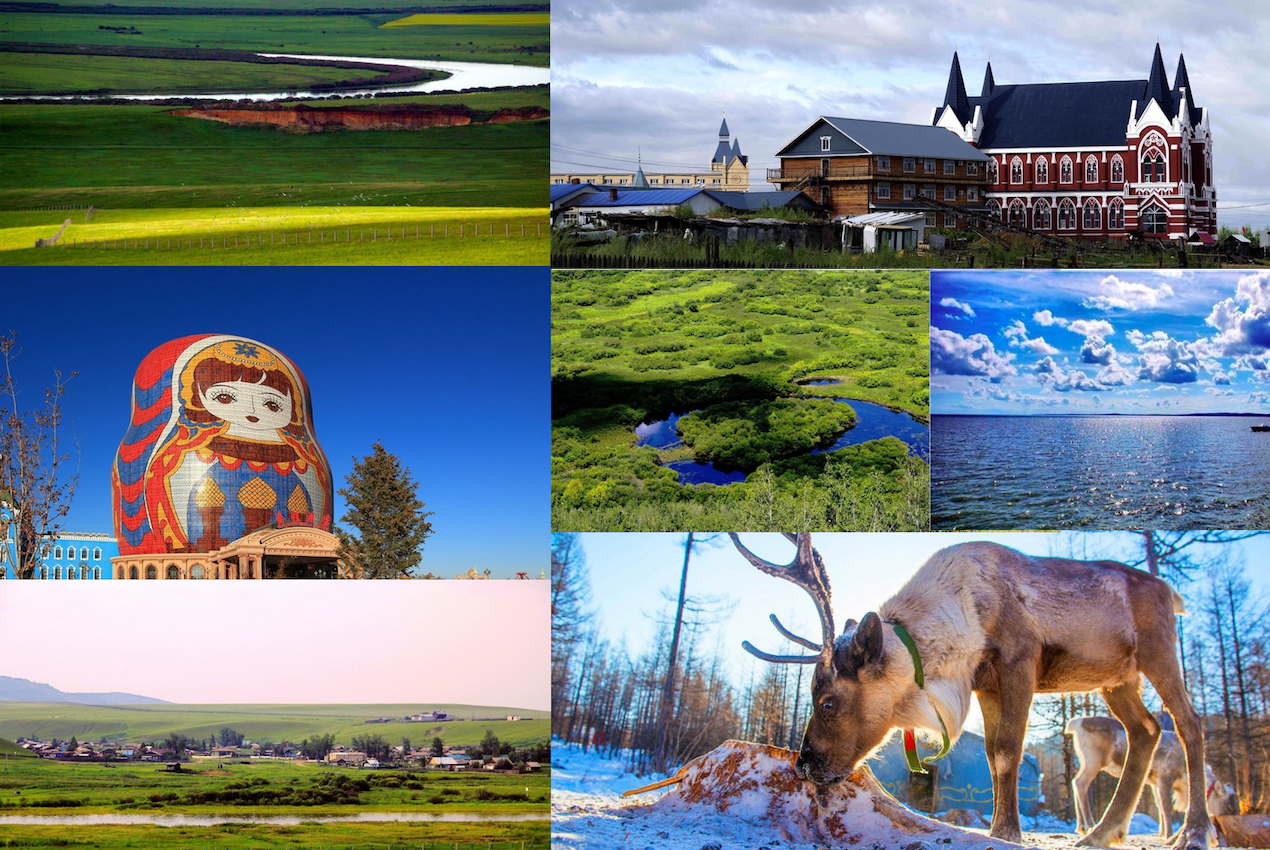
Ready to chase the galloping horse, explore the simply untouched natural beauty and catch a glimpse of Mongolian culture? The 7-day adventure through Hulunbuir below is perfect for travelers looking to connect with nature in the best-preserved grassland in the world. Explore the beautiful surroundings of Hulunbuir Grassland and Ergun Wetland and take part in the featured Mongolian activities. With the opportunity to know the “Ewenki people”, the only hunting tribe in China which keeps its reindeer, this is an adventure that you will never forget.
- Day 1: Hailar arrival. Overnight at Hailar.
- Day 2: Drive to the Hulunbuir Grassland. Overnight at Mongolian yurt.
- Day 3: Drive to Shiwei Town, visit a white birch forest on the way. Overnight at a local Mukeleng Guest House (Russian-style wooden house).
- Day 4: Visit a Russian wooden house built over 100 years ago first, and then loiter along the Argun River. Continue the way to the Moerdaoga National Forest Park. Afterward, drive to Genhe City. Overnight at Genhe.
- Day 5: Drive to Aoluguya to explore a mysterious deer tribe - Ewenki people. Then drive to Ergun City. Overnight at Ergun.
- Day 6: Visit the Ergun Wetland. Afternoon head to Manzhouli. Overnight at Manzhouli.
- Day 7: Visit the Matryoshka Doll Square, then proceed to the Hulun Lake. Afterward, drive to Hailar for the flight out.

From the lush grassland to the vast desert, this 5-day tour immerses you in the rich cultures and landscapes of central and western Inner Mongolia. Stay in traditional Mongolian yurts, travel through the desert on a camel and discover the Tibetan Buddhist shrine in both Baotou and Hohhot. This tour is perfect for travelers looking to discover both the grassland and desert of Inner Mongolia in a short amount of time.
- Day 1: Hohhot arrival. Overnight at Hohhot.
- Day 2: Drive to visit Xilamuren Grassland. Overnight at Mongolian yurts.
- Day 3: Enjoy the sunrise on the grassland, drive to Resonant Sand Bay. Overnight at Baotou.
- Day 4: Visit Wudangzhao Monastery, drive to Hohhot to visit Dazhao temple and Inner Mongolia Museum. Overnight at Hohhot.
- Day 5: Hohhot Departure.

Accommodation and food in Inner Mongolia
Accommodation
When imagining accommodation in Inner Mongolia, travelers would definitely be thinking of yurts - those used by nomads to move around the great prairies. Though staying in a yurt is still possible in grassland areas from late May to August for curious travelers who want a traditional experience, more travelers also want the hotel options for stay in the cities, like most locals live in stone or concrete architectures nowadays. There are many choices in Hohhot - the capital of Inner Mongolia, and Baotou - the largest city in Inner Mongolia, from Luxury 5 star hotels to budget hostels, ranging from CN¥ 200 to over CN¥ 1,000. When getting outside of the major cities to remote areas, the choice will be limited, so it’s better to rely on a local travel agency for useful suggestions or arrange a comfortable stay.
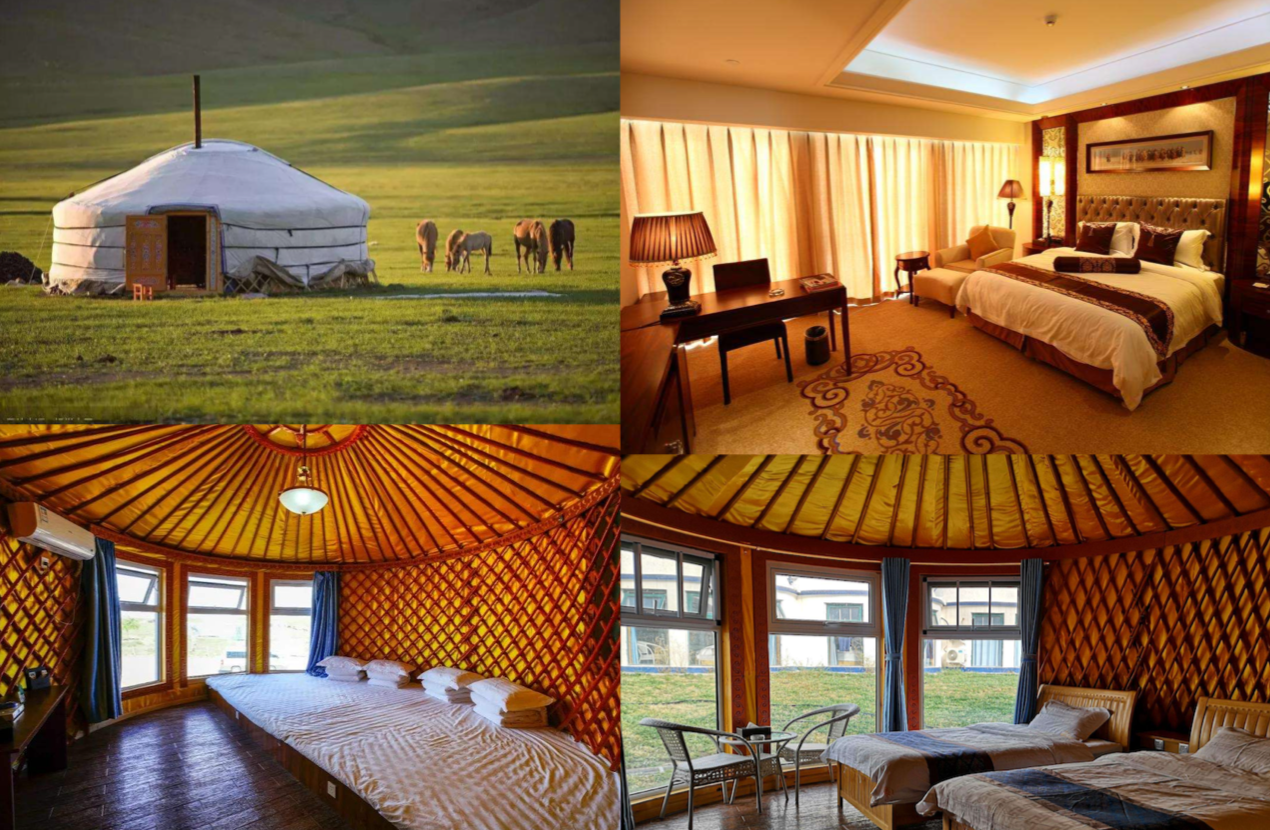
Dining
Traditional Mongolian food dominates in every part of Inner Mongolia, characterized by high dairy products, fatty meats, and wheat-based foods. In terms of drinks, the authentic Mongolian milk tea is an undoubted staple, in a distinctive flavor with salt added, and it is often provided by hotels along with breakfast. Alternatively, try a bottle of the local beer named Xai Bei, which tastes more flavorsome than a lot of Chinese beers. For meals, be prepared to find a menu all about mutton in almost every restaurant, and we would recommend trying some typical dishes, such as roasted lamb, mutton hotpot, and grabbing mutton. For those who are vegetarian or want a break from all the mutton, they can try the delicious buckwheat noodles or the oat flour pancakes.
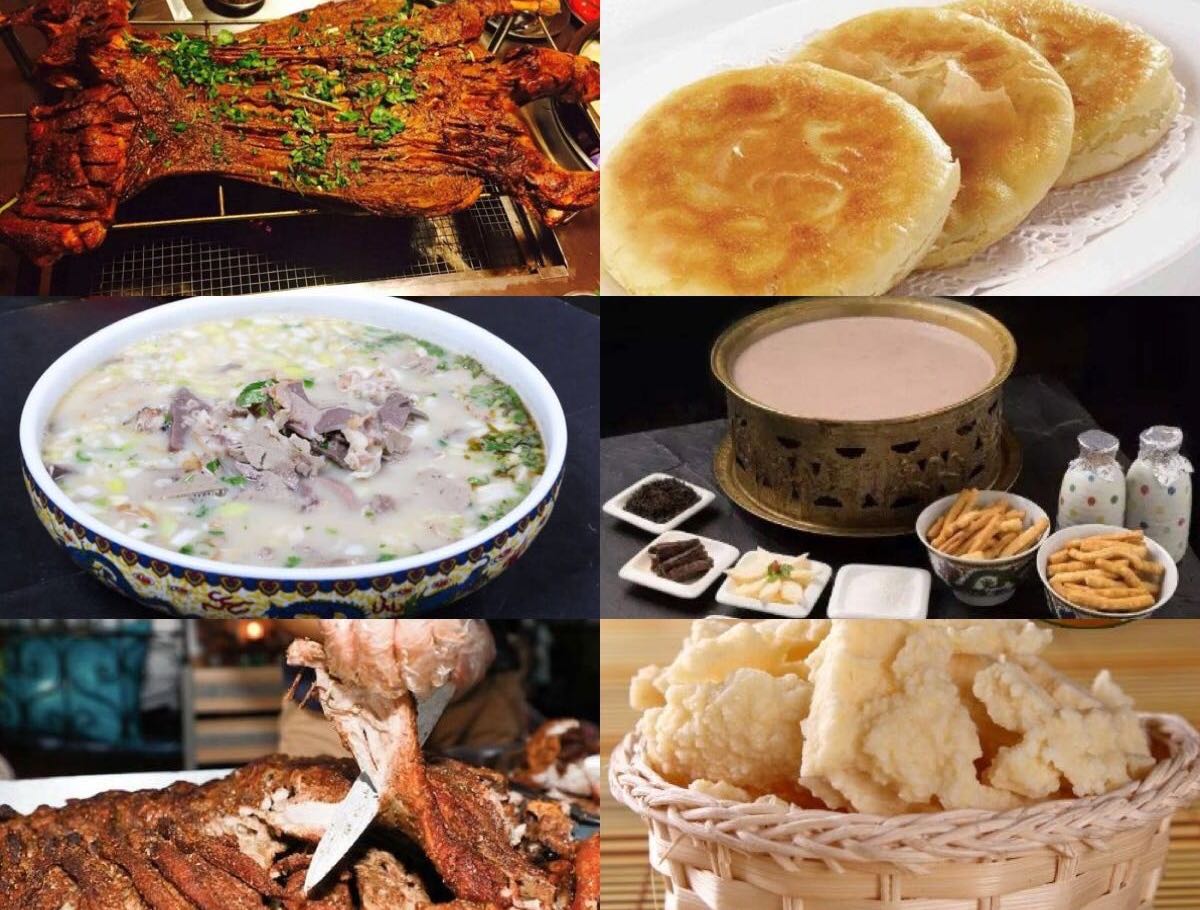

Useful travel tips
- Considering the large temperature difference between morning and evening and strong ultraviolet rays, we would advise bringing a warm jacket, long pants, sports shoes, sunglasses, a hat, and sunblock for travelers who are heading to Inner Mongolia either for grasslands or deserts.
- It is considered an offense to herdsmen if walking through a flock or herd in the grassland, so please be advised not to do so.
- It is a traditional welcome ceremony for nomad families to serve guests with a bowl of milk tea or a sliver cup of local liquor and a Hada, to show their respect to the guests. It is courteous to accept the drink and the Hada with both hands or right hand. For travelers who are not good at drinking, it is okay to take a sip only.

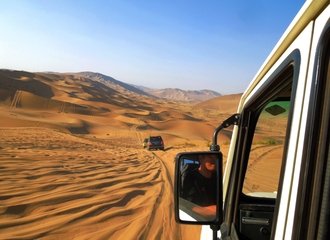
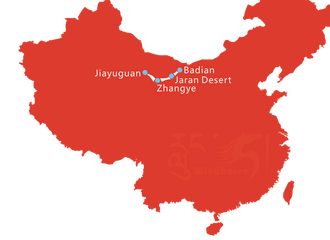

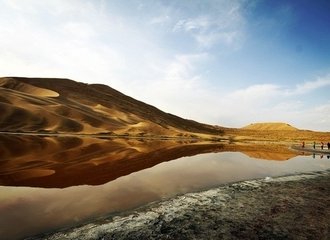
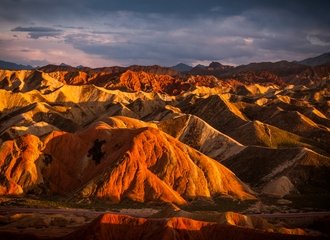
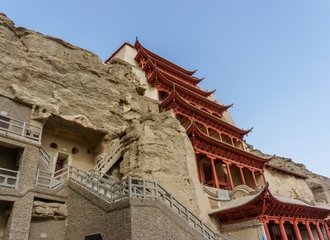
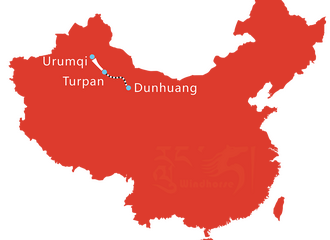
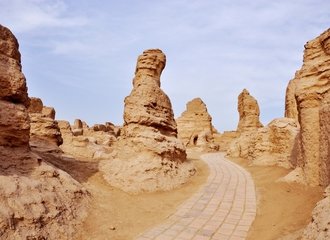
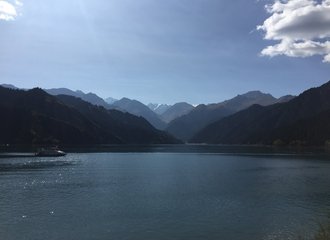
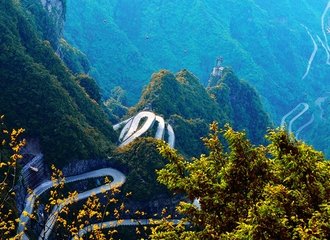
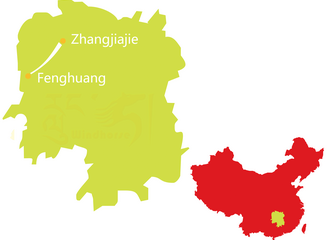
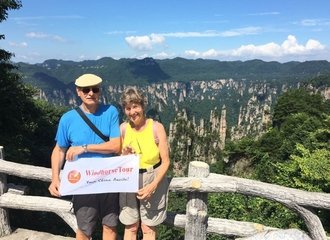
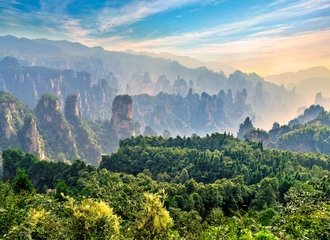
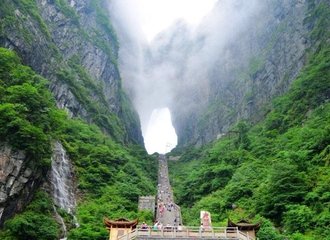
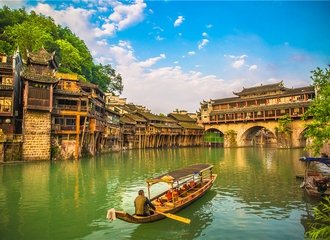
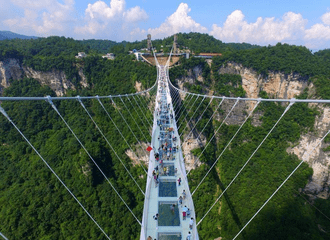

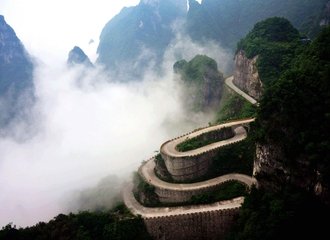
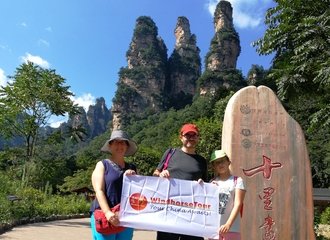
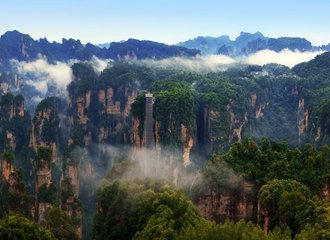

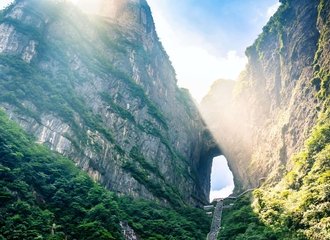
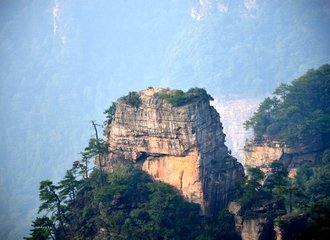
Comments
We would like a guided tour in Inner Mongolia. We would like to spend 7 days there.
In reply to We would like a guided tour… by Law (not verified)
Hello Law,
Thanks for your comments! We would love to arrange your Inner Mongolia tour, I just sent the details to your email, please kindly take a look and feel free to share your thoughts on it.
Look forward to hearing from you back soon.
Best regards,
Yuki